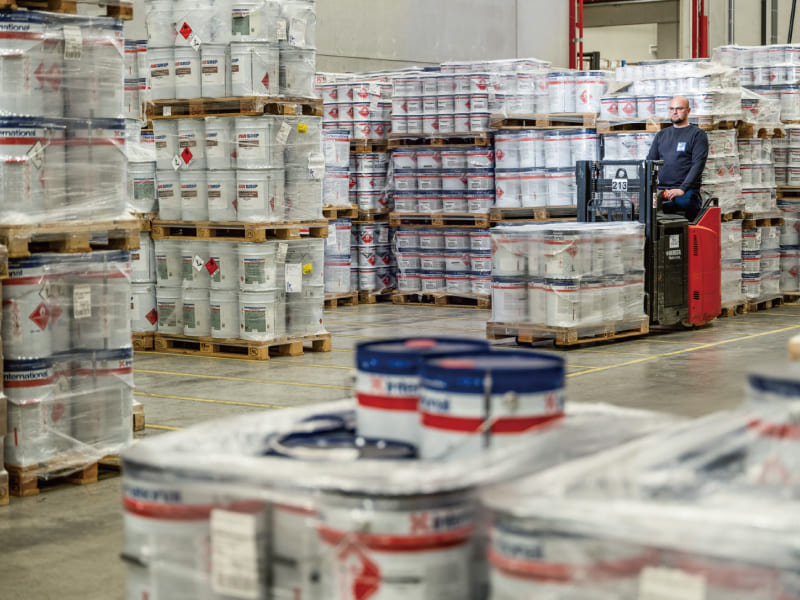What are hazardous Materials in Warehousing
Hazardous materials (Hazmat) refer to any substance that poses a potential risk to health, safety, or the environment if improperly handled. These include toxic chemicals, flammable liquids, oxidizing agents, corrosive substances, and biohazardous materials.
In warehousing, various hazardous items may require specific protocols to ensure safe storage, retrieval, and disposal. Each class of hazardous material demands dedicated strategies for its handling and containment, primarily influenced by the risk factor it presents.

Identifying Hazardous Materials in the Warehouse
Warehouse personnel must be vigilant when dealing with incoming shipments and carefully review labels and documentation to ensure proper classification. Key identification practices include:
- Label Inspection: Look for caution, warning, or danger labels on containers. These indicators are often the first alert to a potentially hazardous item.
- Safety Data Sheets (SDS): Ensure all incoming hazardous shipments include SDS (Safety Data Sheets) for clear information on handling, potential risks, and emergency measures.
- UN List Reference: Cross-check items against the UN list of dangerous goods to confirm classification and handling requirements.
Correct identification ensures that hazardous materials are handled appropriately and stored according to their specific needs, minimizing risks to warehouse personnel.
Hazardous Materials Storage Requirements
Proper storage protocols for hazardous materials are essential to maintaining a safe warehouse environment. Some standard requirements include:
- Segregated Storage: Hazardous materials should be stored separately from regular inventory to minimize contamination and exposure risks.
- Accessible SDS: Keep SDS documentation readily available within the storage area for quick reference in case of an incident.
- Inventory Management: Maintain a separate inventory for hazardous materials to track quantities, expiration dates, and disposal records.
- Spill Control Equipment: Have spill response kits and equipment, such as absorbent materials and protective gear, on hand for prompt spill containment.
- FIFO System: Implement the "First In, First Out" method to ensure that older materials are used first, reducing the chance of storing expired items.

Types of Hazardous Materials and Safe Handling Practices
1. Toxic and Corrosive Substances
These materials pose risks of poisoning and tissue damage upon contact. They should be:
- Sealed and Marked: Toxic items must be well-sealed and clearly labeled, often requiring designated areas within the warehouse.
- Handled with PPE: Personnel handling these items should wear gloves, masks, and protective clothing to avoid exposure.
- Stored Separately: Corrosive substances, such as acids and bases, should be stored separately to prevent reactions and damage to other goods or warehouse structures.
2. Flammable and Combustible Liquids
Flammable materials like gasoline and diesel require stringent safety measures:
- Isolated Storage Area: These substances should be kept in a dedicated storage area, at least 10 meters from the main warehouse.
- Ventilation: Storage areas should be well-ventilated to disperse fumes and reduce ignition risks.
- Clear Marking: Label flammable storage areas and containers to alert personnel to the hazard.
- Fire Safety: Install Class B and Class C fire extinguishers nearby and ensure they are routinely inspected.
3. Pressurized Containers
Compressed gases, whether flammable or inert, can be hazardous if stored improperly:
- Stable Positioning: Secure pressurized containers in a stable, upright position to prevent tipping and ruptures.
- Temperature Control: Keep containers away from heat sources to prevent pressure buildup.
- Valve Protection: Cover valves to avoid accidental damage, especially during transport within the warehouse.
4. Oxidizing Agents
Oxidizers, such as medical-grade disinfectants, can accelerate combustion and should be stored cautiously:
- Separate from Combustibles: These agents should be stored away from fuels and other flammable materials.
- Protective Storage: Use corrosion-resistant shelving, as oxidizers can slowly degrade materials.
- Routine Inspections: Regularly inspect storage areas and shelving for signs of oxidation damage.
5. Biohazardous Materials
Biohazards, including medical waste and biological samples, require specialized handling:
- Access Restriction: Limit access to trained personnel only.
- Temperature Control: Store biohazards at specified temperatures, as required by the substance type.
- Secure Containment: Seal and label containers to prevent accidental exposure and contamination.
Spill Prevention and Response Protocols
Spill Prevention
Spill prevention is a critical component of hazardous materials management. Key strategies include:
- Regular Inspections: Routinely check containers for signs of wear, leaks, or damage.
- Proper Labeling: Ensure all containers are accurately labeled to avoid mishandling.
- Use of Compatible Storage: Store hazardous materials in containers that can withstand their corrosive or reactive nature.
Spill Response
In the event of a spill, follow these steps to contain and clean up safely:
- Alert Personnel: Notify staff to evacuate the area if the spill involves flammable or toxic materials.
- Containment: Use absorbent materials to stop the spill from spreading. For flammable liquids, eliminate ignition sources.
- Protective Gear: Don appropriate PPE, including gloves, masks, and face shields.
- Dispose of Hazardous Waste: Place contaminated materials in sealed, labeled containers, and arrange for disposal with a certified hazardous waste company.
Effective spill response can mitigate environmental and safety risks, preventing contamination and potential injuries.

Compliance with Regulatory Standards
Warehousing hazardous materials requires adherence to national and local regulations. Compliance involves:
- Adhering to Storage Limits: Follow restrictions on the quantity and type of hazardous materials stored, as specified by regulatory agencies.
- Clear Signage: Post hazard signs on storage areas and containers to inform staff and visitors of potential risks.
- Training and Certification: Ensure all warehouse staff handling hazardous materials undergo proper training on regulations and emergency response protocols.
- Documentation: Maintain detailed records of hazardous material inventories, including SDS and disposal logs, to demonstrate regulatory compliance during audits.
Failure to comply with regulatory standards can result in penalties, so it is essential to stay updated on current regulations and best practices.
Best Practices for Hazardous Materials Storage
Implementing structured and safe practices can help create a secure warehouse environment. Consider these tips:
- Regular Training: Conduct frequent training sessions to educate staff on handling and emergency procedures.
- Dedicated Storage Facilities: Where possible, create a separate building or room for hazardous materials to limit exposure.
- Use of Safety Barriers: Install barriers or containment systems around storage areas to prevent accidental exposure or spills.
- Monitor Expiration Dates: Regularly check hazardous materials for expiration and arrange disposal of outdated items.
Conclusion
Properly managing hazardous materials in a warehouse setting is a multi-faceted process that involves careful handling, stringent safety measures, and adherence to regulatory standards.



 ПОДДЕРЖИВАЕМАЯ СЕТЬ
ПОДДЕРЖИВАЕМАЯ СЕТЬ